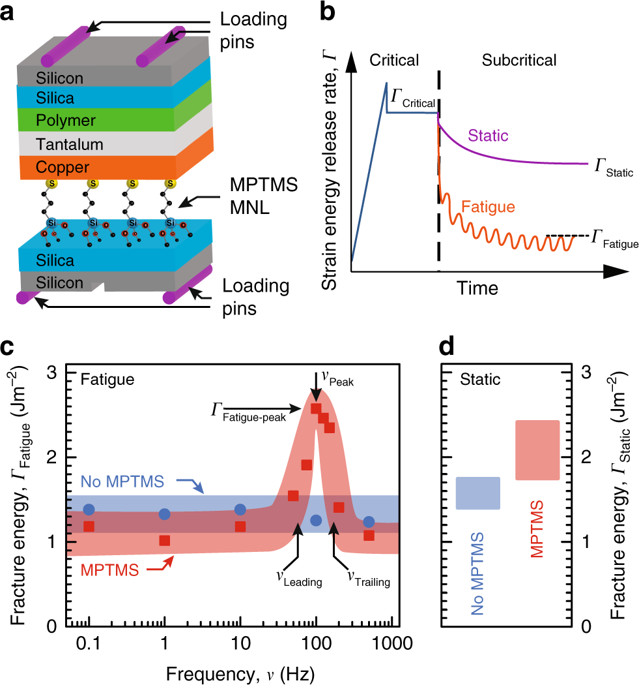当前位置:
X-MOL 学术
›
Nat. Commun.
›
论文详情
Our official English website, www.x-mol.net, welcomes your
feedback! (Note: you will need to create a separate account there.)
Frequency-tunable toughening in a polymer-metal-ceramic stack using an interfacial molecular nanolayer.
Nature Communications ( IF 14.7 ) Pub Date : 2018-12-07 , DOI: 10.1038/s41467-018-07614-y Matthew Kwan , Muriel Braccini , Michael W. Lane , Ganpati Ramanath
Nature Communications ( IF 14.7 ) Pub Date : 2018-12-07 , DOI: 10.1038/s41467-018-07614-y Matthew Kwan , Muriel Braccini , Michael W. Lane , Ganpati Ramanath

|
Interfacial toughening in composite materials is reasonably well understood for static loading, but little is known for cyclic loading. Here, we demonstrate that introducing an interfacial molecular nanolayer at the metal-ceramic interface of a layered polymer-metal-ceramic stack triples the fracture energy for ~75-300 Hz loading, yielding 40% higher values than the static-loading fracture energy. We show that this unexpected frequency-dependent toughening is underpinned by nanolayer-induced interface strengthening, which facilitates load transfer to, and plasticity in, the polymer layer. Above a threshold interfacial bond strength, the toughening magnitude and frequency range are primarily controlled by the frequency- and temperature-dependent rheological properties of the polymer. These results indicate the tunability of the toughening behavior through suitable choice of interfacial molecular layers and polymers. Our findings open up possibilities for realizing novel composites with inorganic-organic interfaces, e.g., arresting crack growth or stimulating controlled fracture triggered by loads with specific frequency characteristics.
中文翻译:

使用界面分子纳米层的聚合物-金属-陶瓷叠层中的频率可调增韧。
复合材料的界面增韧对于静态载荷是相当了解的,但对于循环载荷却知之甚少。在这里,我们证明了在层状聚合物-金属-陶瓷叠层的金属-陶瓷界面处引入界面分子纳米层,可使约75-300 Hz载荷下的断裂能增加三倍,比静态载荷下的断裂能高40%。我们表明,这种意想不到的频率依赖性增韧作用是由纳米层诱导的界面增强所支撑的,这有利于负载转移至聚合物层并在其中产生可塑性。高于阈值界面粘结强度,增韧量和频率范围主要由聚合物的频率和温度相关的流变性质控制。这些结果表明增韧行为的通过界面分子层和聚合物的合适的选择可调谐性。我们的发现为实现具有无机-有机界面的新型复合材料开辟了可能性,例如,阻止裂纹扩展或由具有特定频率特性的载荷触发的受控断裂。
更新日期:2018-12-07
中文翻译:

使用界面分子纳米层的聚合物-金属-陶瓷叠层中的频率可调增韧。
复合材料的界面增韧对于静态载荷是相当了解的,但对于循环载荷却知之甚少。在这里,我们证明了在层状聚合物-金属-陶瓷叠层的金属-陶瓷界面处引入界面分子纳米层,可使约75-300 Hz载荷下的断裂能增加三倍,比静态载荷下的断裂能高40%。我们表明,这种意想不到的频率依赖性增韧作用是由纳米层诱导的界面增强所支撑的,这有利于负载转移至聚合物层并在其中产生可塑性。高于阈值界面粘结强度,增韧量和频率范围主要由聚合物的频率和温度相关的流变性质控制。这些结果表明增韧行为的通过界面分子层和聚合物的合适的选择可调谐性。我们的发现为实现具有无机-有机界面的新型复合材料开辟了可能性,例如,阻止裂纹扩展或由具有特定频率特性的载荷触发的受控断裂。











































 京公网安备 11010802027423号
京公网安备 11010802027423号